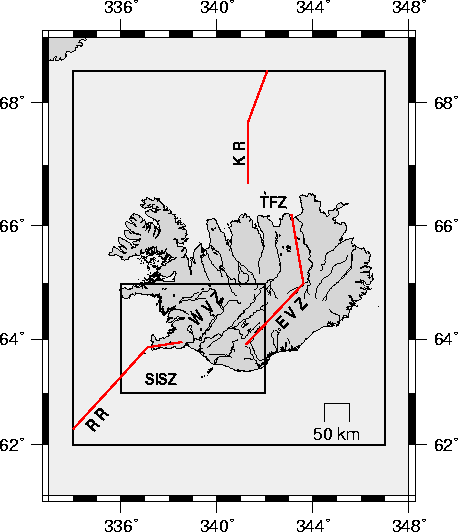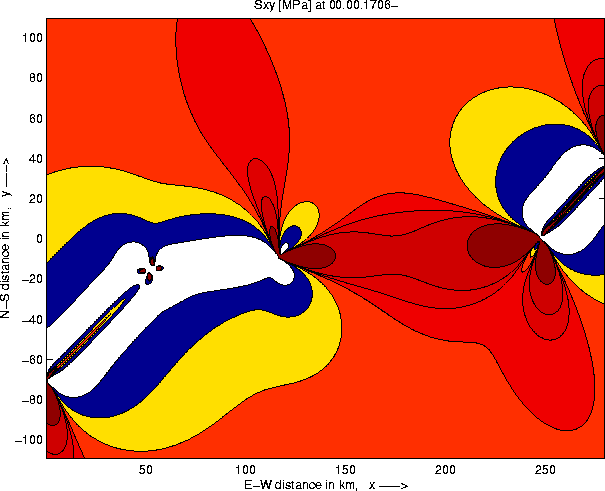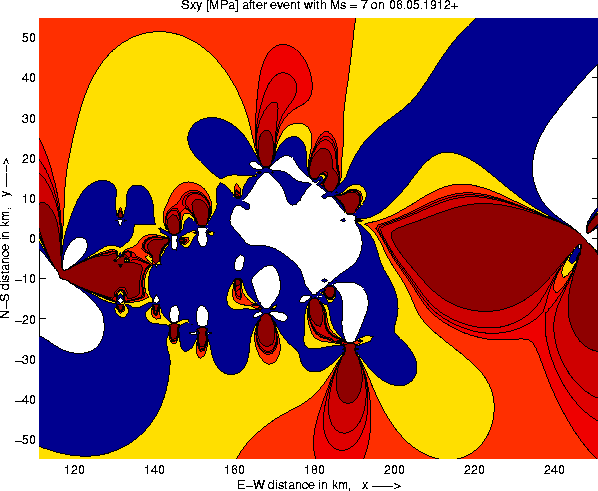


Next: Two problems were addressed
Up: Modelling of the earthquake
Previous: The earthquake data
In the first phase of PRENLAB-2, the models developed in PRENLAB-1 were
improved:
- A
- At the western end of the SISZ, segments with aseismic oblique slip
(mainly normal faulting with a smaller component of left-lateral
strike-slip) were introduced, to better fit the Reykjanes ridge (RR)
between the SW tip of the Reykjanes peninsula to Hengill triple
junction (Figure 28).
- B
- The test-point density was increased from 56x44 (5 km distance) to
280x220 (1 km distance) to get more details of the stress field and
to reduce interpolation errors.
- C
- A layered model, including an inelastic asthenosphere below
a brittle seismogenic upper layer, is in preparation.
- D
- To investigate the model resolution a set of different models is
produced: Besides the main model, several extreme cases
are assumed and the variation of the main results under these
assumptions is observed.
- E
- The stress field at 1912, the end of the series of strong events
with M
 6, is extrapolated to April 1999.
6, is extrapolated to April 1999.
Concerning item A, the RR on Iceland is treated now completely as a zone of
aseismic
rifting, consisting of 2 sections with changing rifting and strike-slip
components to model the bend of the ridge from SW towards the
Hengill triple junction, as displayed in Figure 28.
Doing so, not only the geometry of the rift is better fitted, but also stress
build-up by plate motion is concentrated in the west near the
Hengill triple junction instead of farther west in the RR.
Now, seismic slip is confined to the SISZ ((125, -5) -- (250, 0)),
where the series of strong earthquakes simulated here, took place.
This model was calculated with a test-point spacing of only 1 km (item B). It
will be named "improved model" below.
Figure 28:
Map of Iceland and surrounding area. Thick red lines
indicate mid-Atlantic ridge segments, as used in the PRENLAB-TWO
modelling.
The E-W segment, continuation of RR, was not assumed in the
PRENLAB-1 model (see text).
The smaller box shows the region of the model
on the South Iceland seismic zone. The SISZ extends
approximately between (338.6 E, 63.95
E, 63.95 N) to
(341.2
N) to
(341.2 E, 64
E, 64 N). The large box gives the region for the Iceland rift model.
N). The large box gives the region for the Iceland rift model.
|

A selection of the results obtained by this model is given in Figures
29, 30, and 31.
Figure 29 gives the initial stress field again with the dark red
areas subject to the highest shear stress, now at the rift tip east of
Hengill.
Figure 29:
Shear stress field in the South Iceland seismic zone and its
surroundings as assumed in 1706 ("improved model").(
The same values of the isolines apply as in Figure 32.)
|

Figure 30:
The stress field after the last strong event May 6, 1912, M=7.0
earthquake occurred at (187, -11) in the "improved model".
Here, only the central region of the modelled area is
displayed, so that the details inside the SISZ are clearly visible.
|

The pre-seismic stress level is expected to be smoother than before with the
wider spacing of the test-points. As - at the same change, however - the high
stress tip of the SISZ was shifted to Hengill, the westernmost events
(1706, 1784b, 1896c and e) got into a higher stress region.
This produces a larger scatter of the pre-event stress level,
cf. Figure 31. However, the stress level for the main events
remains in a similar range as before (between 2.0 and 2.8, now between 1.7 and
2.9 MPa).
Figure 31:
Cross plot of the pre-seismic shear stress level at the
site of the impending earthquakes vs. occurrence time.
Here in the "improved model", the stress values at
10 to 70 test-points near the surface trace of the rupture plane
were averaged. --
Letters "a" through "e" denote the events in one year in temporal
sequence.
|




Next: Two problems were addressed
Up: Modelling of the earthquake
Previous: The earthquake data
Margret Asgeirsdottir
1999-12-21